Recently the Washington Post published an article claiming that racially mixed marriages are on the decline, in part because the children of immigrants are increasingly looking for, and presumably finding, partners of the same ethnicity.
The articles cites population studies by sociologist Zhenchao Qian who finds that intermarriage rates for Latinos and Asians in the US –the two ethnoracial groups whose members marry outside their group most—have been declining since 1990. One explanation often given for this trend is a demographic one: as immigration from Latin America and Asia increases, Latinos and Asians in the US have a greater pool of marriageable “co-ethnics” to choose from and thus intermarriage declines. The other kind of explanation cites sociocultural factors, like pressure from parents to marry within their group or a desire to partner with someone who shares one’s traditions, values and aspirations.
While I don’t doubt the finding that intermarriages as a percentage of all marriages are declining for some racial groups, I think caution is warranted in how we interpret these figures. Too often this trend is framed as if it signals some profound shift or reversal in the trend toward greater intermarriage. But as immigration increases, it’s not surprising that a greater percentage of marriages would be intra-ethnic given that more recent arrivals are less likely to be fully embedded in institutions (like jobs and schools) that would facilitate intermarriage.
Trends toward less intermarriage in the second generation, however, are more intriguing. If, as this article implies (I say “if” because I haven’t spent enough time reading the latest population studies on this demographic to evaluate the claim), second generation Asians and Latinos are outmarrying significantly less, this raises some interesting questions about the nature of assimilation that are a lot more complicated than the Post article implies.
Intermarriage is often treated as a measure of assimilation. When an ethnic group becomes sufficiently integrated into the social institutions of a society so as to experience what sociologists Alba and Nee call “easy social intercourse” with the dominant group, intermarriage is more likely. The trend toward less intermarriage, then, might imply that there are significant barriers to such “easy social intercourse”, even for groups, like Asian Americans, who have experienced significant economic and residential mobility.
On the other hand, there may be something else at work in these figures. The Post article spills almost all of its ink on the experiences of young Asian American professionals in the Washington, D.C. area. They profile people looking for love at speed dating events designed specifically for, say, South Asian professionals looking for South Asian professionals; Chinese American professionals looking for Chinese American professionals, etc. “Professionals” is the operative word here, revealing that this is a story at least as much about class as race. And it’s a very old story about how the better-off construct marriage markets from an economic “floor”—eliminating those below their level—while also bounding them by ethnicity.
This class/race pattern of intermarriage would seem to confirm, rather than challenge, the assimilation hypothesis, but take it in new directions. Socially and economically mobile second generation Asian Americans and Latinos may be outmarrying less because they have access to more co-ethnics who have also experienced this mobility. In other words, increasing integration into the mainstream in terms of jobs, housing and income may be facilitating increasing segregation in marriage.

